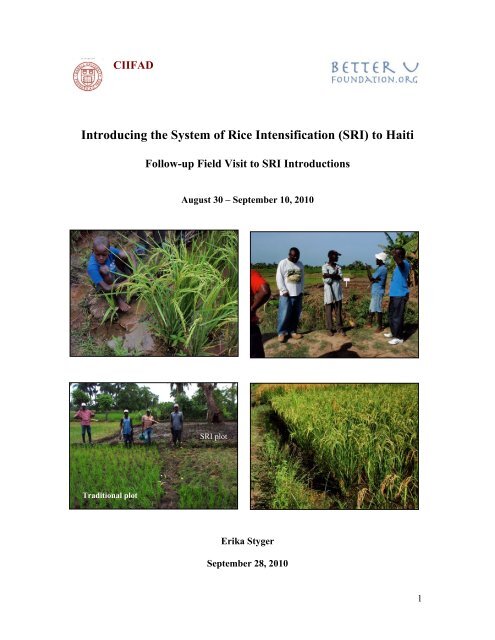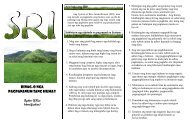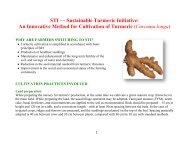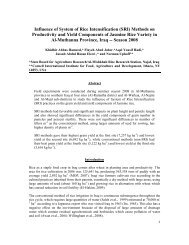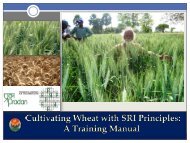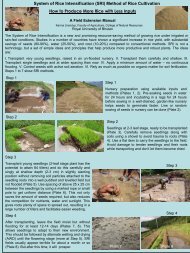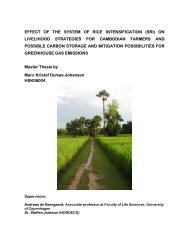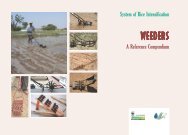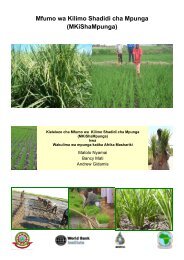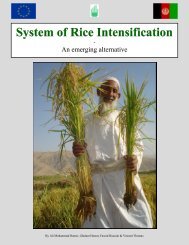Haiti SRI Trip Report Sept2010 Introducing the System of Rice ...
Haiti SRI Trip Report Sept2010 Introducing the System of Rice ...
Haiti SRI Trip Report Sept2010 Introducing the System of Rice ...
You also want an ePaper? Increase the reach of your titles
YUMPU automatically turns print PDFs into web optimized ePapers that Google loves.
CIIFAD<br />
<strong>Introducing</strong> <strong>the</strong> <strong>System</strong> <strong>of</strong> <strong>Rice</strong> Intensification (<strong>SRI</strong>) to <strong>Haiti</strong><br />
Traditional plot<br />
Follow-up Field Visit to <strong>SRI</strong> Introductions<br />
August 30 – September 10, 2010<br />
<strong>SRI</strong> plot<br />
Erika Styger<br />
September 28, 2010<br />
1
1. Introduction<br />
This initiative, carried out by <strong>SRI</strong>-<strong>Rice</strong> at Cornell University with support from Jim<br />
Carrey’s Better U Foundation, responds to <strong>the</strong> concern for <strong>Haiti</strong>’s post-earthquake<br />
recovery and development. <strong>SRI</strong> could help <strong>Haiti</strong>ans to restore food security and increase<br />
<strong>the</strong> pr<strong>of</strong>itability <strong>of</strong> rice cultivation. The objectives <strong>of</strong> this initiative are to: i) establish an<br />
understanding <strong>of</strong> how well <strong>SRI</strong> practices can perform under local conditions, ii) work<br />
with and through established development organizations in <strong>Haiti</strong>, which could carry <strong>the</strong><br />
work forward, and iii) lay <strong>the</strong> groundwork for a larger-scale extension effort to <strong>the</strong> extent<br />
that first-phase results justify it.<br />
Work under this initiative presently is planned to proceed from June 2010 through<br />
January 2011, in three stages: i) train farmers and technicians in <strong>SRI</strong> in three regions <strong>of</strong><br />
<strong>the</strong> country (June 2010), ii) carry out <strong>SRI</strong> field tests with farmers in <strong>the</strong> three regions<br />
(July-October, 2010), and iii) evaluate <strong>the</strong> <strong>SRI</strong> trials and formulate a Phase II program for<br />
<strong>SRI</strong> expansion starting from January 2011 (November 2010 – January, 2011).<br />
Training was finished in June 2010, as summarized in <strong>the</strong> trip report by E. Styger and J.<br />
Barison. The second stage, working with farmers on <strong>the</strong> field tests, involves i) close<br />
email and telephone communication with <strong>SRI</strong> partners from July to November, and ii) a<br />
12-day visit to <strong>Haiti</strong> in early September. This report summarizes <strong>the</strong> field visits and<br />
meetings held during this second trip.<br />
Overview <strong>of</strong> <strong>SRI</strong> introductions<br />
In June, trainings were held in three sites: Les Cayes, Ferrier and Verrette. At all three<br />
sites at least one <strong>SRI</strong> plot was installed (see below for details). Additionally, one <strong>SRI</strong> plot<br />
was planted in planted in Desarmes, one in Pandiassou and one plot is being prepared in<br />
Accajoux. In addition to <strong>the</strong> Cornell <strong>SRI</strong> Initiative, <strong>the</strong> USAID- funded WINNER project<br />
has also introduced <strong>SRI</strong> to <strong>the</strong> three sites <strong>of</strong> Thomazeau, Mirabalais and Gonaives. Thus<br />
in total <strong>the</strong>re were nine <strong>SRI</strong> sites in <strong>Haiti</strong> as <strong>of</strong> September 2010. WINNER hired Joeli<br />
Barison to train staff and farmers and set up demonstration plots in May and June.<br />
Because Joeli was also <strong>the</strong> <strong>SRI</strong> trainer for <strong>the</strong> Cornell/Better U initiative, training<br />
approaches were consistent.<br />
During this trip, I was able to visit six sites: Les Cayes, Thomazeau, Mirabalais, Verrette,<br />
Gonaives, and Ferrier. I learned about <strong>the</strong> three o<strong>the</strong>r sites (Desarmes, Pandiassou and<br />
Accajoux) only after arrival in <strong>Haiti</strong>. Although it was not possible to visit <strong>the</strong>se three<br />
sites, I was able to meet with <strong>the</strong> people responsible for managing <strong>the</strong> plots in two <strong>of</strong> <strong>the</strong><br />
three sites.<br />
2
Figure 1: Seven <strong>of</strong> <strong>the</strong> nine <strong>SRI</strong> sites as <strong>of</strong> September 2010. (Accajoux and Pandiassou are<br />
missing on this figure, located in proximity to Mirabalais)<br />
Location Department Organization Number <strong>of</strong> plots<br />
Les Cayes<br />
Verrette<br />
Desarmes<br />
Ferrier<br />
Gonaives<br />
Mirabalais<br />
Thomazeau<br />
Pandiassou<br />
Accajoux<br />
South<br />
Artibonite<br />
Artibonite<br />
North-East<br />
Artibonite<br />
West<br />
West<br />
West (?)<br />
West (?)<br />
IOM<br />
Centre Formation Lévèque<br />
MCC<br />
World Hunger Relief, Inc.<br />
WINNER<br />
WINNER<br />
WINNER<br />
Frère Franklin<br />
Eglise des Frères<br />
2 plots<br />
1 plot, 1 plot in preparation<br />
1 plot<br />
2 plots, 3 plots in preparation<br />
Demonstration plot &12 farmer plots<br />
Demonstration plot<br />
Demonstration plot, 50 farmer plots prep<br />
1 plot<br />
1 plot in preparation<br />
3
2. Field Visits<br />
2.1. Les Cayes (31 August - 2 September)<br />
<strong>SRI</strong> training and implementation in Les Cayes are led by Brian Flanagan, head <strong>of</strong> <strong>the</strong><br />
PREPEP program (Programme de Revitalisation et de Promotion de l’Entente et de la<br />
Paix – or <strong>Haiti</strong> stabilization program), implemented by IOM (International Organization<br />
for Migration) and funded by USAID. The PREPEP program works to rehabilitate and<br />
improve urban and rural infrastructure in Les Cayes, including parts <strong>of</strong> <strong>the</strong> irrigation<br />
infrastructure <strong>of</strong> <strong>the</strong> 3000 ha Torbeck plain. PREPEP also works with farmers'<br />
associations to improve agricultural production. Brian obtained a small grant for <strong>SRI</strong><br />
training and implementation, and plans to enlarge <strong>the</strong> program due to demand from<br />
farmers.<br />
There are two <strong>SRI</strong> plots in Les Cayes: <strong>the</strong> demonstration plot installed during <strong>the</strong><br />
training, and a new plot transplanted by a volunteer farmer at <strong>the</strong> time <strong>of</strong> this field visit.<br />
Visit to <strong>the</strong> demonstration plot. The plot was at <strong>the</strong><br />
end <strong>of</strong> <strong>the</strong> tillering stage. <strong>SRI</strong> crop performance<br />
seemed no better than <strong>the</strong> traditional practices,<br />
perhaps because <strong>the</strong> plot was not well cared for.<br />
Reasons: i) plot selection was based on its<br />
availability at <strong>the</strong> time <strong>of</strong> <strong>the</strong> training. The farmer<br />
and technicians did not know each o<strong>the</strong>r<br />
previously and did not work well toge<strong>the</strong>r; ii) The<br />
plot was flooded most <strong>of</strong> <strong>the</strong> time during <strong>the</strong><br />
vegetative period due to heavy rains, and because<br />
<strong>the</strong>re was no drainage; iii) <strong>the</strong> cono-weeder was not available in time, thus <strong>the</strong> plot had to<br />
be weeded by hand. At <strong>the</strong> time <strong>of</strong> <strong>the</strong> visit, <strong>the</strong> plot was under weed pressure. Although<br />
<strong>the</strong> farmer had applied organic matter, and added some fertilizer to half <strong>of</strong> <strong>the</strong> plot, some<br />
yellowing <strong>of</strong> <strong>the</strong> part <strong>of</strong> <strong>the</strong> plot without fertilizer was observed.<br />
Newly transplanted plot: A volunteer farmer Wilsonne Suppre transplanted three <strong>SRI</strong><br />
subplots on <strong>the</strong> day <strong>of</strong> our visit. Although <strong>the</strong> farmers used a marker, <strong>the</strong>y had problems<br />
keeping <strong>the</strong> lines straight on this ra<strong>the</strong>r large plot. We helped with some technical advice<br />
so that <strong>the</strong> techniques for planting in line could be better followed for <strong>the</strong> second and<br />
third plot. This experience serves as a reminder that it is important to assist farmers when<br />
<strong>the</strong>y plant an <strong>SRI</strong> plot for <strong>the</strong> first time.<br />
4
Volunteer Wilsonne Suppre who<br />
prepared <strong>SRI</strong> plots<br />
Brian Flanagan earned dirty boots<br />
and a sunburn for helping out with<br />
<strong>the</strong> transplanting<br />
Visit to <strong>the</strong> Taiwanese rice project<br />
Farmers transplanting <strong>the</strong>ir first <strong>SRI</strong> subplot<br />
Second <strong>SRI</strong> subplot is transplanted (left), <strong>the</strong> third is almost<br />
done (right)<br />
The Taiwanese are funding a rice project in <strong>the</strong> Torbeck plain (3000 hectares) next to Les<br />
Cayes. Support covers <strong>the</strong> entire rice value chain: technical assistance to improve yields,<br />
better milling equipment, and support for marketing <strong>the</strong> product. We met with <strong>the</strong> <strong>Haiti</strong>an<br />
project manager and five Taiwanese technicians whose expertise includes rice<br />
5
production, mechanization, and irrigation infrastructure. Although Joeli had given a<br />
presentation about <strong>SRI</strong> to <strong>the</strong> group in June, <strong>the</strong>y have not yet established a <strong>SRI</strong> plot, but<br />
confirm <strong>the</strong>ir interest in doing so.<br />
The Taiwanese promote planting rice in lines and use <strong>of</strong> <strong>the</strong> cono-weeder, and actually<br />
had a number <strong>of</strong> cono-weeders available, manufactured locally from a prototype imported<br />
from Taiwan. They also promote use <strong>of</strong> fertilizer, improved varieties, and improved soil<br />
preparation, all subsidized by <strong>the</strong> project. Their approach seems ra<strong>the</strong>r top-down and<br />
input-oriented, and it is questionable to what extent <strong>the</strong> farmers will be able to maintain<br />
<strong>the</strong> techniques once <strong>the</strong>y are no longer subsidized .<br />
The Taiwanese cono-weeder seemed<br />
to weigh less than <strong>the</strong> one produced by<br />
<strong>the</strong> welder shop GRADES in Nor<strong>the</strong>rn<br />
<strong>Haiti</strong>. The Taiwanese graciously gave<br />
me a cono-weeder, which I turned<br />
over to <strong>the</strong> WINNER project in Portau-Prince.<br />
WINNER has arranged<br />
with a good agricultural machine shop<br />
to make enough weeders from <strong>the</strong><br />
Taiwanese design for both <strong>the</strong><br />
WINNER and Cornell/Better U <strong>SRI</strong><br />
partners. Each <strong>of</strong> our partners will<br />
receive a prototype weeder which can<br />
be copied locally. Ideally, both <strong>the</strong><br />
Taiwanese weeder and <strong>the</strong> GRADES<br />
weeder should be comparatively tested<br />
in <strong>the</strong> field to see which works best, and to see if elements from one can be used to<br />
improve <strong>the</strong> o<strong>the</strong>r.<br />
Weeder demonstration and field visit<br />
Taiwanese weeder (top),<br />
GRADES weeder (bottom)<br />
The Taiwanese specialists accompanied us in <strong>the</strong> afternoon to test <strong>the</strong> weeders with<br />
farmers and hold discussions with a group <strong>of</strong> farmers, which was enriching for all<br />
participants. The Taiwanese agreed to help IOM harvest <strong>the</strong> two <strong>SRI</strong> plots, as <strong>the</strong>y have<br />
<strong>the</strong> equipment and know <strong>the</strong> methodology to do so.<br />
6
Weeder demonstration Lively discussions between farmers, IOM and Taiwanese<br />
technicians<br />
Technicians from <strong>the</strong> NGO known as SEED (Service <strong>of</strong> Evangelisation, Education and<br />
Development) who attended <strong>the</strong> <strong>SRI</strong> training, had planned to follow up on <strong>the</strong> <strong>SRI</strong> plot<br />
toge<strong>the</strong>r with IOM. This did not happen because <strong>the</strong> designated technician left <strong>the</strong> project<br />
soon after <strong>the</strong> training and has not been replaced. Thus, SEED has not been present in <strong>the</strong><br />
field since <strong>the</strong>n.<br />
Outlook for Les Cayes<br />
Brian Flanagan plans to develop a small <strong>SRI</strong> sub-project under IOM and is looking for<br />
funding within his organization. Ideally, he would hire a technician to work closely with<br />
volunteer farmers. Farmers at <strong>the</strong> Les Cayes site can plant rice at any time during <strong>the</strong><br />
year, which makes it easier to organize <strong>the</strong> work according to both farmers’ and<br />
technicians’ availability. It allows farmers to witness <strong>SRI</strong> plots in different development<br />
stages at any given time. It is important that one volunteer farmer already started his own<br />
<strong>SRI</strong> plot, which will serve as an example to o<strong>the</strong>rs.<br />
2.2. Visit to Leveque Training Center in Verrette (4 September)<br />
Josaphat Vilna is pr<strong>of</strong>essor at <strong>the</strong> Agricultural Faculty <strong>of</strong> <strong>the</strong> University Notre Dame<br />
d’<strong>Haiti</strong> in Port-au-Prince, and former director <strong>of</strong> ODVA (Organisation de<br />
Développement de la Vallée d’Artibonite) who has established a private training center<br />
and associated farm in Verrette. Vilna installed a <strong>SRI</strong> plot at a river crossing where many<br />
people pass, ensuring high visibility. At <strong>the</strong> time <strong>of</strong> my visit, <strong>the</strong> plot was at <strong>the</strong> end <strong>of</strong><br />
tillering stage. Two doses <strong>of</strong> fertilizer (total <strong>of</strong> 90kg N, 90 kg P, 45 kg K) were applied,<br />
7
ut no organic matter. The owner <strong>of</strong> <strong>the</strong> plot reports a plant with 55 tillers, a new record<br />
for her, as normally this variety achieves a maximum <strong>of</strong> 15-20 tillers. The plants looked<br />
very vigorous, and <strong>the</strong> plot looked homogenous. The plot had been weeded three times by<br />
hand, and no weeds were seen in <strong>the</strong> plots. Participants in <strong>the</strong> visit included <strong>the</strong> head <strong>of</strong><br />
livelihood program from WINNER, head <strong>of</strong> seed production at ODVA (Organisation de<br />
Développement de la Vallée d’Artibonite), head <strong>of</strong> <strong>the</strong> commune agricultural service , and<br />
two technicians from MCC (Mennonite Central Committee), who installed a <strong>SRI</strong> plot in<br />
<strong>the</strong> neighboring commune <strong>of</strong> Desarmes. Unfortunately, we were not able to visit <strong>the</strong><br />
MCC plot, but we did discuss plot management with <strong>the</strong> technicians.<br />
Field visit with farmers and technicians from ODVA,<br />
government agriculture service, MCC, WINNER and<br />
Cornell University (Pr<strong>of</strong>. Vilna: second from left, owner<br />
<strong>of</strong> <strong>the</strong> plot: third from left)<br />
<strong>SRI</strong> rice plant in Verrette<br />
Vilna integrates livestock with rice<br />
cropping systems on this farm. <strong>Rice</strong><br />
straw, used as litter for chickens and<br />
ducks, is used to fertilize <strong>the</strong> fishponds,<br />
where it feeds plankton, which are <strong>the</strong>n<br />
consumed by <strong>the</strong> fish. When <strong>the</strong> fishpond<br />
is becomes too heavily populated with<br />
plankton, some <strong>of</strong> that nutrient-rich water<br />
can be drained for irrigation, and<br />
replaced by fresh water, thus reducing<br />
plankton levels. Vilna will integrate <strong>SRI</strong><br />
into this system by locating a <strong>SRI</strong> plot<br />
next to one <strong>of</strong> <strong>the</strong> fishponds (see picture,<br />
where soil preparation is underway for a <strong>SRI</strong> plot), where it will be irrigated by <strong>the</strong><br />
nutrient-rich fishpond water. He claims that it is difficult to find organic matter for <strong>the</strong><br />
8
<strong>SRI</strong> plot, so fishpond water can be used instead for fertilization. Vilna, who is well<br />
regarded in <strong>the</strong> area, would be happy to accommodate students on his farms, and<br />
continue testing innovations. He also runs a pleasant and well-organized training center.<br />
2.3. Field visit to Ferrier (7 - 9 September)<br />
<strong>Rice</strong> cultivation in Ferrier is influenced by <strong>the</strong> rains in <strong>the</strong> nearby mountains, which cause<br />
various levels <strong>of</strong> flooding during <strong>the</strong> rainy season. Optimal rice growing season is from<br />
January with harvest in June, before <strong>the</strong> rains start, or from October, after <strong>the</strong> end <strong>of</strong> <strong>the</strong><br />
rains. If farmers plant late (from March until August), <strong>the</strong> standing rice crop coincides<br />
with <strong>the</strong> rainy season, and <strong>the</strong>re is a chance <strong>of</strong> damage or destruction <strong>of</strong> <strong>the</strong> rice crop by<br />
flooding.<br />
The training in June was not a good time for farmers to start <strong>SRI</strong> plots. Never<strong>the</strong>less,<br />
farmers installed a demonstration <strong>SRI</strong> plot with <strong>the</strong> seedlings produced during <strong>the</strong><br />
training. World Hunger Relief Inc. has identified two motivated farmers, Elisma and<br />
Erick, who have been hired to work with farmers once a week to install and manage <strong>the</strong>ir<br />
<strong>SRI</strong> plots. <strong>SRI</strong> work through September is summarized below:<br />
Elison: The <strong>SRI</strong> demonstration plot was done on Elison’s land. The planted variety CK7<br />
developed very well, and showed high tiller numbers <strong>of</strong> 20-27 after six weeks. At two<br />
months, a free-ranging herd <strong>of</strong> cows entered <strong>the</strong> plot and destroyed <strong>the</strong> rice crop entirely.<br />
Elison decided to plow <strong>the</strong> <strong>SRI</strong> plot under and prepare it again toge<strong>the</strong>r with his larger<br />
field. He plans to replant one part with <strong>SRI</strong>.<br />
Elison is plowing under <strong>the</strong> <strong>SRI</strong> plot (see ox<br />
plowing in <strong>the</strong> back <strong>of</strong> <strong>the</strong> picture) that was<br />
devastated by a herd <strong>of</strong> cows<br />
Farmer technicians Erick and Elisma and farmer<br />
Elison (from left to right) discuss reinstalling<br />
<strong>the</strong> <strong>SRI</strong> plot<br />
Erick prepared a plot for transplanting in July, but it was flooded for over 30 days just at<br />
<strong>the</strong> moment he had planned to plant. He plans to try again in January, when <strong>the</strong>re will be<br />
no flooding danger.<br />
9
Elisma planted a <strong>SRI</strong> plot two days before our visit, and a second plot was ready to be<br />
transplanted when we arrived. The transplanted plot looked good. Passing farmers<br />
comment that <strong>the</strong> plants are much too little, and one plant will be unlikely to produce<br />
much. In a neighboring field we counted up to about 10 seedlings per hill.<br />
First plot was transplanted two days before<br />
this photo was taken.<br />
Second plot is ready to be transplanted from<br />
a 13 day-old nursery<br />
Antoine Julien participated in <strong>the</strong> training and is preparing <strong>the</strong> land for a <strong>SRI</strong> plot.<br />
Jean Willio did not participate in <strong>the</strong> training, but witnessed <strong>the</strong> development <strong>of</strong> Elison’s<br />
plot and is currently preparing his land for a <strong>SRI</strong> plot.<br />
In summary, one plot had been transplanted, one plot was to be transplanted <strong>the</strong> same day<br />
(both for Elisma), and three plots are prepared (Elison, Antoine, Jean). As <strong>the</strong> rainy<br />
season comes to an end, <strong>the</strong> risk <strong>of</strong> flooding is decreasing.<br />
Despite <strong>the</strong> difficulties from flooding and destruction <strong>of</strong> <strong>the</strong> <strong>SRI</strong> demonstration plot by<br />
free-roaming cattle, farmers are preparing <strong>SRI</strong> plots for planting toward <strong>the</strong> end <strong>of</strong> <strong>the</strong><br />
rainy season, when <strong>the</strong>re is less risk <strong>of</strong> flooding. It can be recommended to provide<br />
fur<strong>the</strong>r training (including in data collection) for <strong>the</strong> two farmer trainers, and to develop a<br />
more structured program, an exchange visit to <strong>the</strong> WINNER sites in Gonaives, and<br />
fur<strong>the</strong>r training in data collection for <strong>the</strong> farmer trainers.<br />
2.4. WINNER sites in Thomazeau, Mirabalais and Gonaives (3 - 5 September)<br />
At <strong>the</strong> three sites -- Thomazeau, Mirabalais and Gonaives -- WINNER has installed <strong>SRI</strong><br />
demonstration plots with three promising varieties: TCS10, a high-yielding 120-day<br />
short-straw variety, and Shelda and Shela, two highly-priced, popular varieties, each with<br />
a shorter 105-day cropping cycle and moderate yields. There are three treatments: i) <strong>SRI</strong><br />
with organic matter, ii) <strong>SRI</strong> with fertilizer, and iii) traditional practice. When I visited,<br />
both Shela and Shelda varieties were ready for harvest.<br />
10
<strong>SRI</strong> demonstration plots in Thomazeau <strong>SRI</strong> demonstration plot in Mirabalais<br />
<strong>SRI</strong> demonstration plots in Gonaives Roosevelt Decimus (front), head <strong>of</strong> livelhood<br />
program <strong>of</strong> WINNER, discusses <strong>the</strong> <strong>SRI</strong> plots<br />
with technician Max Augustin in Gonaives<br />
The demonstration plots are located in <strong>the</strong> middle <strong>of</strong> farmers’ fields, allowing farmers to<br />
observe <strong>the</strong> plots carefully over <strong>the</strong> growing season. Farmers are apparently very<br />
interested in <strong>SRI</strong>. In Thomazeau, 50 farmers asked for help with <strong>the</strong> <strong>SRI</strong> implementation,<br />
and soil preparation is currently underway. In Gonaives, 12 farmers have already<br />
installed <strong>SRI</strong> plots, even before <strong>the</strong> demonstration plots were harvested.<br />
11
12 farmers in Gonaives have installed <strong>SRI</strong> plots after having visited <strong>the</strong> demonstration plots.<br />
The difference between <strong>SRI</strong> and traditional practices was remarkable, even though <strong>the</strong><br />
cono-weeding could not be applied. Hand weeding was done using a small hoe, imitating<br />
<strong>the</strong> effect <strong>of</strong> <strong>the</strong> cono-weeder. It is noteworthy that <strong>the</strong> traditional plots with Shelda and<br />
Shela had <strong>the</strong> tendency to lodge, which was not <strong>the</strong> case in <strong>the</strong> <strong>SRI</strong> plots.<br />
Shela variety in traditional plot is starting to<br />
lodge (fall down). The plants in <strong>the</strong> two pictures<br />
are <strong>the</strong> same age and come from <strong>the</strong> same seed<br />
Shela variety in <strong>the</strong> <strong>SRI</strong> plot is staying upright<br />
despite <strong>the</strong> higher number <strong>of</strong> panicles per plant,<br />
and <strong>the</strong> heavier panicles<br />
Main constraints for <strong>the</strong> WINNER project were problems with <strong>the</strong> weeder and nonavailability<br />
<strong>of</strong> organic matter. The weeder (sarcleuse rotative) Joeli that had brought<br />
from Madagascar does not work well on <strong>the</strong> heavy clay soils <strong>of</strong> most WINNER sites;<br />
thus <strong>the</strong> weeder could not be used. However, <strong>the</strong> cono-weeder from <strong>the</strong> Taiwanese should<br />
work well on heavy clay soils.<br />
In addition, unavailability <strong>of</strong> organic matter is a major constraint. Farmers have never<br />
applied organic matter to <strong>the</strong>ir lowland rice fields, although <strong>the</strong>y complain that soil<br />
fertility is declining, and that <strong>the</strong>ir soils are now ‘addicted’ to chemical fertilizers, and<br />
12
can no longer produce a good yield without <strong>the</strong>m. This indicates that organic matter is<br />
depleted and <strong>the</strong> soils have lost natural fertility. Also, <strong>the</strong> old varieties that produced<br />
without dependence on fertilizer applications are becoming more difficult to find (this<br />
was mentioned by <strong>the</strong> Gonaives farmers). It is recommended that WINNER develop<br />
local strategies for organic matter production and application to <strong>the</strong> <strong>SRI</strong> plots in order to<br />
address <strong>the</strong> sustainability issue.<br />
3. Meetings<br />
3.1. Oxfam Intermon and Oxfam America<br />
Mme Marie Denise Samson, Oxfam Intermon<br />
Oxfam Intermon works on rice production in <strong>the</strong> Artibonite valley in <strong>the</strong> six communes<br />
<strong>of</strong> Verrette, Lestere, Dedunes, Grande Saline, Dessalines, and Petite Riviere. They<br />
employ one supervisor, four agronomists, and 21 field agents. To date <strong>the</strong>ir efforts have<br />
focused on improving soil fertility, water and pesticide management, and transplanting.<br />
Oxfam Intermon was not able to support <strong>the</strong> <strong>SRI</strong> initiative this season because it was not<br />
possible to shift funds from ano<strong>the</strong>r project. Despite this temporary constraint, Marie-<br />
Denise confirmed Oxfam Intermon’s interest in designing a <strong>SRI</strong> program.<br />
Jacobo Ocharan, Oxfam America<br />
Oxfam America (OA) is also starting a rice production program in <strong>Haiti</strong>. Although <strong>the</strong><br />
head <strong>of</strong> program Jacobo Ocharan was not in <strong>Haiti</strong> during my visit, I was able to speak<br />
with him on <strong>the</strong> phone. Oxfam America is undertaking a formal study <strong>of</strong> <strong>the</strong> rice sector in<br />
order to better target its eventual program. OA can benefit from all <strong>of</strong> our <strong>SRI</strong> contacts<br />
across <strong>the</strong> country. It would like to stay in close contact and join <strong>the</strong> <strong>SRI</strong> evaluation<br />
meeting to be held in December. Oxfam America will complete planning for its rice<br />
program by November/December. We will see to what extent <strong>SRI</strong> is included.<br />
3.2. MCC (Mennonite Central Committee)<br />
Sue Brown (Coordinator <strong>Haiti</strong> Response Team)<br />
Kurt Hildebrand (Country Representative)<br />
MCC confirmed its interest in working on <strong>SRI</strong>. MCC's focus is directed toward <strong>the</strong><br />
integration <strong>of</strong> various activities that have a positive impact on livelihoods. <strong>SRI</strong>, like any<br />
o<strong>the</strong>r activity, should not be considered as an isolated intervention, but should<br />
complement o<strong>the</strong>r livelihood improvement strategies. A couple from Canada has been<br />
hired to work in Artibonite from December 1 st, and will start up MCC's <strong>SRI</strong> program.<br />
13
Four people from MCC Artibonite took part in <strong>the</strong> training in June: two technicians and<br />
two farmers. MCC has installed a <strong>SRI</strong> plot in Desarmes, which is now at 30 days after<br />
transplanting. Kurt arranged for <strong>the</strong> MCC staff from Desarmes to meet us during <strong>the</strong> field<br />
visit in Verrette. I gave <strong>the</strong>m <strong>the</strong> technical guidelines, and we were able to discuss in<br />
detail some <strong>of</strong> <strong>the</strong> technical steps.<br />
3.3. WINNER project<br />
Mario Kerby, Deputy Director<br />
WINNER started working with <strong>SRI</strong> in June 2010 with demonstration plots on three sites,<br />
which have generated much interest from farmers. Its next step -- to install <strong>SRI</strong> plots<br />
toge<strong>the</strong>r with farmers -- is already taking place in Gonaives, and soil preparation is<br />
underway in Thomazeau.<br />
WINNER’s approach following this introductory phase will be to consolidate <strong>the</strong> good<br />
crop performance with <strong>the</strong> farmers. WINNER's role includes <strong>SRI</strong> dissemination, training<br />
support, and scaling-up. The WINNER and <strong>the</strong> Cornell initiatives complement each o<strong>the</strong>r<br />
very well, as Cornell works in important rice-growing areas where WINNER is not<br />
present. Possible opportunities for collaboration were discussed:<br />
<strong>SRI</strong> technical manual: Mario was very interested in <strong>the</strong> technical manual that we have<br />
begun to put toge<strong>the</strong>r. WINNER would be interested in helping to fur<strong>the</strong>r develop our<br />
manual into small booklets with photos or drawings that could be used as extension<br />
material by technicians and farmers in <strong>the</strong> field.<br />
Field visits: WINNER is willing to receive visitors from o<strong>the</strong>r sites, and organize farmerexchange<br />
visits, so that farmers from o<strong>the</strong>r regions can directly interact with <strong>SRI</strong> farmers<br />
under WINNER .<br />
First <strong>SRI</strong> workshop: WINNER is willing to partner with Cornell to hold a workshop<br />
where farmers, technicians, and o<strong>the</strong>r interested parties can share <strong>the</strong>ir <strong>SRI</strong> experience.<br />
The workshop could include a field visit to a WINNER site close to Port-au-Prince. A<br />
good date for <strong>the</strong> workshop has yet to be identified; scheduling must take into account<br />
both <strong>the</strong> Presidential elections on November 28 (around which time it would be unwise to<br />
hold <strong>the</strong> workshop), and <strong>the</strong> rice-growing season around <strong>the</strong> capital, so that <strong>SRI</strong> plots can<br />
be visited close to Port-au-Prince. A proposed date is now in January 2011.<br />
3.4. KPL<br />
Harry Nicholas, Director<br />
KPL (“Consume Locally”) would like to start working directly with two identified<br />
14
farmers’ associations (one in <strong>the</strong> South, <strong>the</strong> o<strong>the</strong>r one in Gonaives, close to WINNER’s<br />
site) and cover <strong>the</strong> entire value-chain from production to commercialization. KPL (see<br />
previous trip report, page 14) has fur<strong>the</strong>r developed its ideas since we last met. Its would<br />
like to make locally-produced rice available in a form attractive to consumers, to better<br />
compete with <strong>the</strong> imported rice from <strong>the</strong> USA. Subsidized, lower-cost rice imported from<br />
<strong>the</strong> USA has largely destroyed demand for local rice. KPL would like to develop<br />
attractive and affordable local rice, and is currently drawing up a concept note for this<br />
idea.<br />
3.5. Eglise des Frères<br />
Bily Jean, Agronomist and church member<br />
Église des Frères is present in Accajoux and in Sodo. Bily Jean, a member <strong>of</strong> <strong>the</strong> church,<br />
is a trained agronomist and took part in <strong>the</strong> training at Verrette. The church group has<br />
begun soil preparation for a <strong>SRI</strong> plot and will transplant within <strong>the</strong> next few days. Bily<br />
Jean seems determined to work on <strong>SRI</strong> as an alternative to current rice cultivation<br />
practices.<br />
4. Preparing <strong>the</strong> third stage<br />
4.1. Evaluation workshop<br />
The third stage <strong>of</strong> introducing <strong>SRI</strong> to <strong>Haiti</strong>, as described in <strong>the</strong> introduction, is evaluation<br />
<strong>of</strong> <strong>the</strong> current <strong>SRI</strong> trials and planning <strong>the</strong> second phase for <strong>SRI</strong> expansion. The<br />
Cornell/Better U Initiative and <strong>the</strong> USAID-funded WINNER project will jointly hold this<br />
workshop, inviting those who have installed a <strong>SRI</strong> plot during <strong>the</strong> past season to evaluate<br />
<strong>the</strong> outcome. O<strong>the</strong>r invitees will include organizations that work in rural development<br />
and rice production, including <strong>the</strong> government’s agriculture service. Participants will be<br />
introduced to <strong>SRI</strong>, hear about actual experience using <strong>SRI</strong> practices from those who have<br />
done it, and visit a <strong>SRI</strong> plot to see it first-hand. Interested participants will plan a<br />
coordinated program to implement <strong>SRI</strong> activities (e.g., coordinate training programs) for<br />
Phase II.<br />
4.2. Additional considerations<br />
<strong>Haiti</strong>an capacity for technical assistance needs to be fur<strong>the</strong>r developed. Because it is<br />
important to have good resource people available within <strong>the</strong> country, <strong>the</strong> main objective<br />
is to create a pool <strong>of</strong> expert <strong>Haiti</strong>an technicians who can both manage <strong>SRI</strong> programs and<br />
train o<strong>the</strong>rs to do so. Training should focus on practical extension so that widespread<br />
adoption can happen quickly, and also include data collection and analysis. Training to<br />
date has laid <strong>the</strong> foundation, but more is needed. Local technical capacity needs to be<br />
much stronger if this program is to go fur<strong>the</strong>r.<br />
15
Funding needed for Phase II: People representing a number <strong>of</strong> programs expressed <strong>the</strong>ir<br />
interest in continuing to work on <strong>SRI</strong>. Some organizations have funding for it, o<strong>the</strong>rs do<br />
not. During <strong>the</strong> evaluation workshop, it will be possible to identify what funding is<br />
available for Phase II, where <strong>the</strong>re are gaps, and where fur<strong>the</strong>r founding may be found.<br />
4.3. Technical remarks<br />
- In much <strong>of</strong> <strong>Haiti</strong>, rice can be grown year-round. This brings enormous<br />
advantages: farmers can begin using <strong>the</strong> <strong>SRI</strong> methodology at almost any time<br />
during <strong>the</strong> year. Learning about <strong>SRI</strong> is not dependent on <strong>the</strong> season, which should<br />
allow this innovation to spread more quickly.<br />
- In several locations, farmers asked if <strong>SRI</strong> methodology is also suitable for rainfed<br />
rice. It will be important to integrate adaption <strong>of</strong> <strong>SRI</strong> principles to o<strong>the</strong>r crops.<br />
- One major constraint is <strong>the</strong> non-availability <strong>of</strong> organic matter. In a number <strong>of</strong> <strong>SRI</strong><br />
plots, no organic matter was applied, only chemical fertilizers were used. It will<br />
be important to develop a number <strong>of</strong> techniques for farmers to produce organic<br />
matter to fertilize <strong>the</strong>ir soils.<br />
16
Impressions from Port-au-Prince<br />
17
Calendar<br />
<strong>SRI</strong> Training in Les Cayes, South Department by Joeli Barison<br />
August 30 -‐ Travel from Ithaca New York to Port-au-Prince<br />
August 31 -‐ Meeting with Marie-Dense Samson, Oxfam Intermon<br />
-‐ Travel from Port-au-Prince to Les Cayes<br />
-‐ Meeting with Brian Flanagan, IOM<br />
Sept 1 -‐ Visit <strong>SRI</strong> demonstration plot<br />
-‐ Visit 2 nd <strong>SRI</strong> plot during transplanting operations<br />
-‐ Meeting with Staff <strong>of</strong> Project de Riziculture de Torbeck<br />
-‐ Lunch with Staff <strong>of</strong> Project de Riziculture de Torbeck<br />
-‐ Test <strong>of</strong> weeder in <strong>SRI</strong> demonstration plot with Taiwanese, discussion with<br />
farmers<br />
-‐ Visit <strong>of</strong> Taiwanese project facilities, including agricultural equipment<br />
Sept 2 -‐ Travel from Les Cayes to to Port-au-Prince<br />
-‐ Meeting with Sue Brown and Kurt Hildebrand, MCC<br />
Sept 3 -‐ Field visit <strong>of</strong> Thomazeau Winner <strong>SRI</strong> project site<br />
-‐ Field visit <strong>of</strong> Mirabalais Winner <strong>SRI</strong> project site<br />
Sept 4 -‐ Field visit <strong>of</strong> Verrettes and Gonaives<br />
Sept 5 -‐ Field visit Gonaives, travel to Port-au-Prince<br />
Sept 6 -‐ <strong>Report</strong> writing (Labor day)<br />
Sept 7 -‐ Meeting with Mario Kerby; Travel to Cap <strong>Haiti</strong>en and Ferrier<br />
Sept 8 -‐ Field visit to Ferrier<br />
Sept 9 -‐ Travel to Cap <strong>Haiti</strong>en and Port au Prince,<br />
-‐ Meeting with Harry Nicholas, KPL<br />
-‐ Meeting with Jean Bily, Eglise des Freres<br />
Sept 10 -‐ Meeting with Roosevelt Decimus, and Mario Kerby, WINNER<br />
-‐ Travel from Port-au-Prince to Ithaca, New York<br />
18
People met<br />
19


